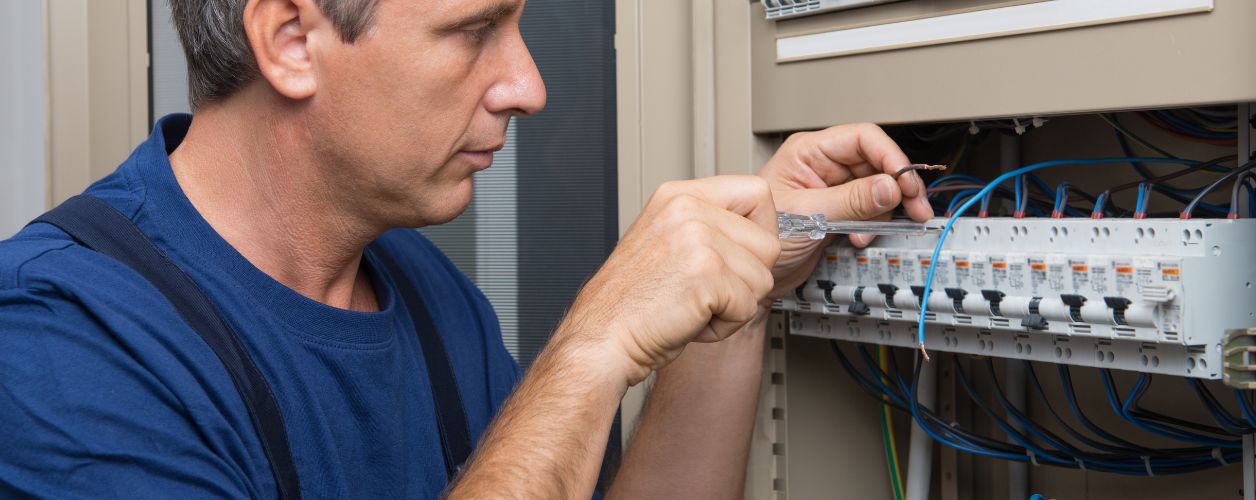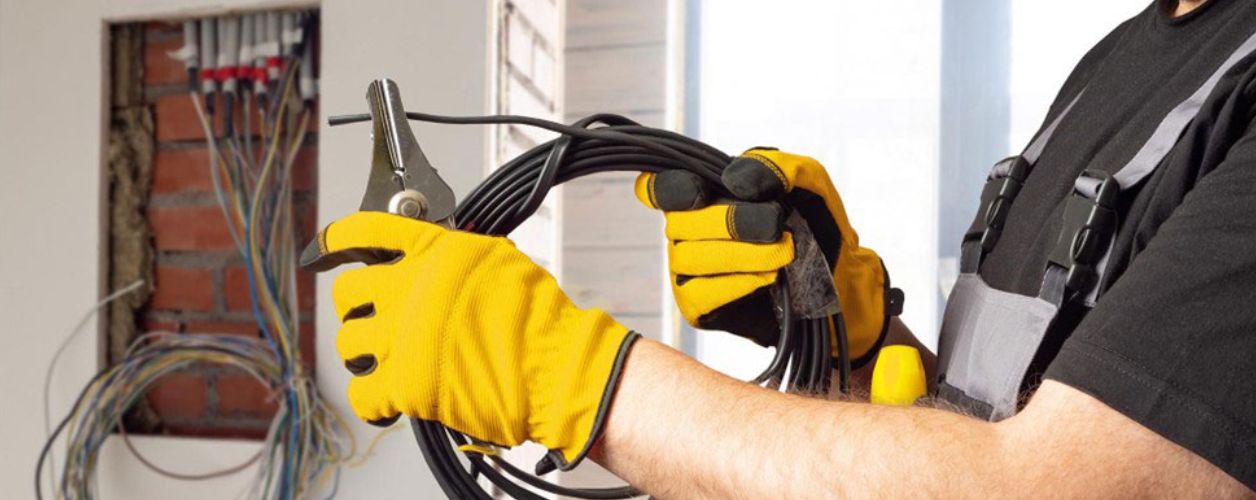Get free quotes within minutes
Circuit Breaker Tripping? Here’s What It Means

Table Of Contents
- Introduction
- What Is a Circuit Breaker and What Does It Do?
- Why Do Circuit Breakers Trip?
- How to Reset a Tripped Breaker?
- When to Call an Electrician
- Preventing Breaker Trips in the Future
- What About GFCI and AFCI Breakers?
- Circuit Breaker vs. Fuse Box: What’s the Difference?
- Conclusion
Circuit Breaker Tripping? Here’s What It Means
It’s a typical evening. While you prepare dinner and watch TV, and operate the dishwasher, everything suddenly becomes dark. You check your electrical panel only to find that one of your circuit breakers has tripped. Again.
The experience of having an electrical circuit breaker trip points to important indicators. Tripping circuit breakers may present only minor problems but can indicate underlying serious issues. Both homeowners and renters need to understand circuit breaker tripping causes because it directly affects their safety and comfort.
Home circuits are controlled by separate breaker switches, enabling homeowners to diagnose and manage their system more effectively.
What Is a Circuit Breaker and What Does It Do?
Your home electrical system depends on circuit breakers to offer safety from overloaded circuits and defective wiring, and short circuits. A circuit breaker functions as an electrical guardian for your residence. When too much electricity flows through a circuit or something goes wrong, like a frayed wire, a malfunctioning appliance, or a sudden power surge, the breaker quickly “trips.” A breaker clicks on to disconnect power flow from a particular system segment, thus blocking possible threats from overheating or electrical fires and electric shocks.
The circuit breaker can be found inside the breaker panel, which is commonly referred to as the electrical panel or fuse box, situated in a garage or basement or utility room, or hallway. The various circuit breakers embedded within your home let you control electrical pathways to specific areas like kitchen areas, living rooms, and HVAC to quickly pinpoint areas that require maintenance or inspection. Circuit breakers seem better for contemporary homes since they let users reset them, while traditional fuses require complete replacement.
Why Do Circuit Breakers Trip?
The knowledge of circuit breaker trip reasoning helps you tackle the problem on your own or choose when to rely on expert help. Here are the most common reasons your circuit breaker may trip:
Overloaded Circuit
Breaker trips primarily occur due to overloaded circuits. A circuit overload occurs when the circuit handles electric power beyond its safe capacity. Linking space heaters with microwaves and coffee makers to a single outlet or circuit will exceed the power capacity, leading to an electrical breaker intervention that shuts down power.
- Common signs of an overloaded circuit:
- Lights dimming or flickering when appliances run
- Outlets or plugs that feel warm to the touch
- A buzzing or humming sound from outlets
- The same breaker tripping repeatedly
Fix:
Simply disconnect select devices from the main circuit and distribute them to other available circuits. Such a solution provides momentary relief. Constant circuit overloading requires professional help because an electrician will determine your needs and then install appropriate outlets and circuits.
Short Circuit
Live wires will short out both when they touch neutral wires or other live wires and cross paths with unintended conductive materials. The fast electric surge sparks an instant interruption by the breaker to stop fire or shock hazards.
Short circuits create a more severe situation than overloads because they signal either damaged wires or defective electrical outlets, or malfunctioning electrical appliances.
- Warning signs of a short circuit:
- The breaker trips immediately after you reset it
- A strong burning smell or smoke
- Scorch marks or blackened outlets/switches
Fix:
All attempts to fix short circuits should be left to professional electricians who will handle the task correctly. The danger involved could produce electric shocks and might start a fire. You must contact a licensed electrician for both a safe inspection and repair.
Ground Fault
The ground fault shares similarities with short circuits because it occurs when a hot wire comes into contact with either the ground wire or the wire enclosure. Standards consider the areas with significant moisture content in bathrooms or kitchens and outdoor areas prone to ground faults.
Signs of a ground fault:
- Breaker trips when using appliances near water
- Shocks or tingling sensations when touching appliances or switches
Fix:
You can restore GFCI (Ground Fault Circuit Interrupter) operation by pushing the “Reset” button on the outlet. Contact a specialist for help when an outlet keeps tripping after reset attempts or refuses to reset after trying the reset button. Your system needs immediate professional help when you detect ground faults because this means water has invaded your system or your insulation has failed, or your wiring shows damage.
Faulty Appliances
A defective appliance can be the origin of the breakdown rather than your electrical wiring or circuitry. Old or damaged appliances, such as microwaves and air conditioners, and vacuums, create excessive power consumption that triggers the electrical breaker to trip when power is turned on.
Fix:
Plug the appliance into another outlet located on a different circuit to test the existing condition. The breaker tripping twice in a row indicates that the appliance needs repair or replacement.
Loose Wiring or Aging Electrical Components
Electrical systems don’t last forever. The combination of old wires and rusty electrical connections or loose terminals found in outlets, switches, and the breaker panel can trigger sporadic breaker tripping. Unidentified wiring defects pose serious fire hazards that become dangerous when untreated.
Fix:
The problem requires specialized skills beyond what regular homeowners can handle. The inspection and correction of loose or degraded wiring should fall under the responsibility of a licensed electrician. Electrical inspections that occur regularly detect dangerous wiring issues in old homes prior to dangerous conditions emerging.
Learning what makes your breaker trip enables you to determine whether the problem demands professional help or if you can handle it easily yourself.
How to Reset a Tripped Breaker?
If you’ve identified a tripped breaker, follow these steps to reset it:
- You should disable all appliances connected to the affected circuit as a precaution against additional overload issues.
- Examine your breaker panel to find a switch that should be either in the middle position or "off".
- Firmly push the breaker to the "off" position and then back to "on."
- Examine the situation further or contact a professional if the breaker continues to trip immediately.
When to Call an Electrician
A tripping breaker presents more than a momentary annoyance at times. Here’s when it’s time to bring in the pros:
- The circuit breaker repeatedly activates on its own without showing any visible triggers.
- Electricity issues indicate problems in outlets or board panels, which produce a burning smell or manifest visible damage.
- Electrical noises like buzzing, popping, and sizzling will come from your electrical panel.
- Your house lights experience repeated dimming and flashing after you connect electrical devices.
- Resetting the breaker seems unsafe to you.
Home electrical fires rank as one of the main reasons behind residential fires throughout the United States. Seek help from professionals if you feel the problem extends beyond your ability to diagnose.
Preventing Breaker Trips in the Future
There are several steps you should take ahead of time, which will help minimize the frequent tripping of your circuit breakers despite unavoidable occurrences such as appliance failures during storms or power surges.
Distribute Appliances Evenly
Overload prevention begins with distributing electrical devices across different outlets. You should distribute high-wattage appliances such as space heaters along with toasters and microwaves to separate outlets and circuits. A circuit will trip if too many energy-demanding devices exist in the same location.
Tip: Track your appliance locations to identify specific outlets or rooms that cause frequent power failures before relocating them.
Upgrade Your Electrical Panel
Older houses typically use 100-amp panels because they were adequate for previous decades, yet fall short in supplying power for today's technology requirements. Due to the increasing usage of electronic devices along with smart appliances, your electrical system may become overloaded.
Solution: Your home would benefit from replacement with a 200-amp panel, together with extra circuit installations, which will distribute power more evenly. Homeowners who upgrade their electrical system will experience the elimination of power outages and obtain the ability to install EV charging stations and solar panel arrays later on.
Install Dedicated Circuits
Air conditioners and microwaves, together with dishwashers and washing machines, and dryers, create a significant electrical draw. The distribution of multiple appliances on one circuit leads to repeated tripped breakers.
Fix: Hire an electrician to establish independent power lines specifically for large household appliances. The dedicated circuit path provides each device with its route to avoid contact with lower-power devices and lowers the chance of circuit overload.
Use Surge Protectors
The areas that commonly experience lightning strikes and voltage spikes, or power outages need surge protectors as the primary protective measure. Power surges that enter your network wiring and important electronic devices are blocked by protective surge protectors.
Tip: Install individual point-of-use surge protectors for computers and televisions, and request a whole-house surge protector installation from your electrician to cover the panel and surrounding areas.
Schedule Regular Inspections
Circuit components, together with wires, demonstrate wear and tear most notably in older residential buildings. Breakers extricate power from your electrical system when loose connections collaborate with degraded wiring because of age-related corrosion.
Recommendation: Get your electrical system inspected every 5 to 10 years by a licensed electrician because homes older than 30 years need inspections more frequently. During inspections, electricians examine both system damages and outdated components, and safety hazards while ensuring that all components fulfill present-day electrical rules.
What About GFCI and AFCI Breakers?
Modern homes often have specialized breakers with built-in safety features:
GFCI (Ground Fault Circuit Interrupter)
Ground faults require protection through this device in all wet areas such as kitchens, bathrooms and outdoor locations, and garages.
AFCI (Arc Fault Circuit Interrupter)
Your residence, constructed at least three decades ago, probably accommodates a fuse box instead of a contemporary circuit breaker panel. The National Electrical Code now specifies that these safety features must be installed in bedroom areas as well as living spaces, in addition to other designated areas.
What If the Breaker Doesn’t Reset?
If your breaker trips and won’t stay in the “on” position, it could be:
- A persistent short circuit
- Faulty breaker
- Ground fault or arc fault
- An overloaded circuit with a connected device still drawing power
Don’t force the breaker. Failing to maintain the on position of the breaker signifies a dangerous electrical problem. Cover all devices connected to the circuit and attempt restoration of power. Contact an electrician because the issue requires professional diagnosis.
Circuit Breaker vs. Fuse Box: What’s the Difference?
The basic functions remain the same for both devices, but they work differently due to independent advantages and disadvantages that come with each option. Power management systems depend on these devices to prevent damage and short circuits, yet they function in different ways with trade-offs between the two methods.
How Fuses Work
Fuses hold a narrow piece of metal that melts after excessive current flows through it. When the strip melts due to excessive current, the circuit breaks and electricity stops flowing. The fusion process disrupts electrical flow, yet demands complete fuse replacement after each failure.
How Circuit Breakers Work
The resettable nature of circuit breakers defines their operation. An overloaded electrical system or fault causes breakers to move to the “off” position. Restoring power only requires flipping the breaker back to its original position without requiring any part replacements.
Conclusion
The regular breaker tripping stands as a warning about issues that require electrical system examination. Basic electrical problems usually resolve themselves when you unplug devices, but complex problems need professional intervention by an electrician. After initial steps fail to address electrical problems, professionals need to handle ongoing repairs of several electrical issues.
Electrical system emergencies include repetitive breaker trips as well as unusual signs like furnace odors and noisy electrical outlets. House owners who want to find their ideal roof can discover essential information by studying the benefits and corresponding limitations of different options. It is safer to take necessary precautions because uncertainty leads to worry. Call a licensed electrician for proper diagnosis, followed by fixing solutions, because it is the way to ensure your home's safe electrical environment.
Capital Cities
- Electrician Services in Montgomery
- Electrician Services in Juneau
- Electrician Services in Pago Pago
- Electrician Services in Phoenix
- Electrician Services in Little Rock
- Electrician Services in Washington, D.C.
- Electrician Services in Washington, D.C.
- Electrician Services in Washington, D.C.
- Electrician Services in Sacramento
- Electrician Services in Denver
- Electrician Services in Hartford
- Electrician Services in Dover
- Electrician Services in Washington, D.C.
- Electrician Services in Palikir
- Electrician Services in Tallahassee
- Electrician Services in Atlanta
- Electrician Services in Hagåtña
- Electrician Services in Honolulu
- Electrician Services in Boise
- Electrician Services in Springfield
- Electrician Services in Indianapolis
- Electrician Services in Des Moines
- Electrician Services in Topeka
- Electrician Services in Frankfort
- Electrician Services in Baton Rouge
- Electrician Services in Augusta
- Electrician Services in Majuro
- Electrician Services in Annapolis
- Electrician Services in Boston
- Electrician Services in Lansing
- Electrician Services in Saint Paul
- Electrician Services in Jackson
- Electrician Services in Jefferson City
- Electrician Services in Helena
- Electrician Services in Lincoln
- Electrician Services in Carson City
- Electrician Services in Concord
- Electrician Services in Trenton
- Electrician Services in Santa Fe
- Electrician Services in Albany
- Electrician Services in Raleigh
- Electrician Services in Bismarck
- Electrician Services in Saipan
- Electrician Services in Columbus
- Electrician Services in Oklahoma City
- Electrician Services in Salem
- Electrician Services in Ngerulmud
- Electrician Services in Harrisburg
- Electrician Services in San Juan
- Electrician Services in Providence
- Electrician Services in Columbia
- Electrician Services in Pierre
- Electrician Services in Nashville
- Electrician Services in Austin
- Electrician Services in Salt Lake City
- Electrician Services in Montpelier
- Electrician Services in Charlotte Amalie
- Electrician Services in Richmond
- Electrician Services in Olympia
- Electrician Services in Charleston
- Electrician Services in Madison
- Electrician Services in Cheyenne







